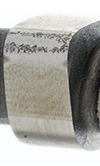Hertzian stresses
 The surface of a camshaft or its associated follower can fail in a number of ways. Adhesive wear leading to abrasive wear, and corrosive wear, are perhaps the most common but another type of wear - surface fatigue - is sometimes perhaps harder to understand.
The surface of a camshaft or its associated follower can fail in a number of ways. Adhesive wear leading to abrasive wear, and corrosive wear, are perhaps the most common but another type of wear - surface fatigue - is sometimes perhaps harder to understand.
Adhesive/abrasive wear tend to be lubricant-based issues. Poor lubrication or an incorrectly specified lubricant - it amounts to the same thing - will cause the oil film to break down under extreme loads, producing metal-to-metal contact causing abrasive wear (scuffing or scoring) or in severe cases, adhesive wear. Commonly avoided in competition engines by careful running-in using oils with high anti-wear additives, this subject has been discussed briefly elsewhere in RET-Monitor.
Corrosion, however, can cause other forms of camshaft surface failure. It's perhaps not as common as it once was, as high levels of base additive are now introduced to engine lubricants to 'mop up' much of the strong and weak acids produced as a result of combustion before they can harm the exposed surface of the cam.
If oils were not 'fully formulated' to contend with extended operation, the cam surface could become pitted very quickly, triggering scoring or abrasive wear as soon as the engine started running again. This sometimes makes corrosive wear very difficult to diagnose, but if engines are left lying around unused for weeks on end - as in the case of many weekend racers - other signs of pitting on the cam or follower might give the game away.
The most difficult form of surface failure to diagnose is that which results from surface fatigue. Thankfully very rare and perhaps seen only in engine development workshops, this form of surface failure is associated with the fatigue effect of what is more commonly known as the Hertzian stresses in a cam.
In a typical poppet valve, spring and cam arrangement, and whether the cam is rotating or not, the force of the compressed spring reacts through the tappet to produce a load on the cam surface. In any high-speed valve gear, it can be appreciated that the greatest load at high engine speeds occurs on the opening flank of the cam, while at low speed the highest load is to be found on the nose of the cam.
Classical analysis of the forces in and around the contact zone, (assuming the usual isotropic and elastic properties of the metal) shows that the maximum compressive stress (?z) is produced at the centre of the contact patch between the cam and its follower, perpendicular to the surface. Two other principal stresses (and using the conventional polar coordinate suffixes r and ?) ?r and ?? are also exist. At this point the failure criteria of the maximum shear stress as a result of the combined effect of these is comparatively small. As we travel down into the material of the cam in the direction of the z axis, however, these shear stresses build up to a maximum at a depth below that of the contact area.
These are called Hertzian stresses, and increase steadily to a maximum at what is therefore the weakest point in the material. Should they for any reason exceed the maximum allowable for the material, micro-cracks will inevitably result which, when subjected to repeated cyclic loading, will join together with other similar features and cause the surface material to break away, leaving a hole or pit in the surface of the cam. These stresses are very much a function of the contact loads at the cam-tappet contact point, as well as the instantaneous radius of curvature of the two components as they touch.
To the skilled eye, the pitting produced by failures of this type will be immediately obvious, as will the remedial actions necessary to correct the design.
Fig. 1 - Surface fatigue leading to cam-lobe pitting
Written by John Coxon